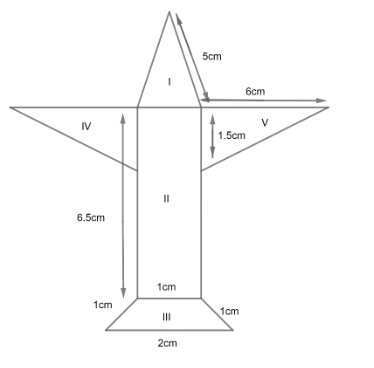
Answer
498.9k+ views
Hint: Find the area of all the shapes individually and then find summation of them to get the whole area of the given aeroplane. Use the symmetric property of a given aeroplane to find all the required sides of the shapes.
Picture of aeroplane made by Radha is given as;
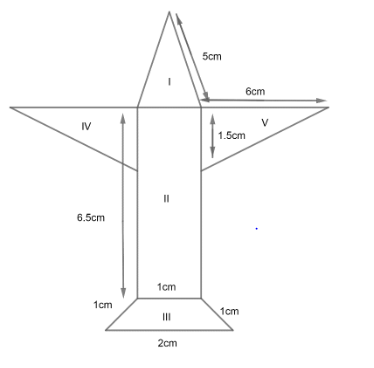
Here, we have 5 shapes included in the picture of the aeroplane. Hence, we need to find the area of each shape to get the area of aeroplane.
Area of aeroplane = Area of (I + II + III + IV + V)………………… (1)
Area of shape I i.e. $\Delta ABC$ can be calculated as;
As, $\Delta ABC$ is an isosceles triangle i.e. AB = AC and length BC = IF by symmetry of the given aeroplane.

Now, area of $\Delta ABC=\dfrac{1}{2}\times AM\times BC$…………………… (2)
Where AM is drawn as perpendicular to side BC.
Now, $\Delta ABM\text{ and }AMC$are congruent to each other in following way;
$\begin{align}
& AB=AC=5cm \\
& AM=AM\left( Common \right) \\
& \angle AMB=\angle AMC=90{}^\circ \\
\end{align}$
Hence, by RHS property $\Delta ABM\cong AMC$.
So, BM = MC by CPCT.
So, now we have;
$BM=MC=\dfrac{1}{2}$
To find AM, apply Pythagoras Theorem to triangle AMC, we get
$\begin{align}
& A{{C}^{2}}=A{{M}^{2}}+M{{C}^{2}} \\
& {{\left( 5 \right)}^{2}}=A{{M}^{2}}{{\left( \dfrac{1}{2} \right)}^{2}} \\
& 25-\dfrac{1}{4}=A{{M}^{2}} \\
\end{align}$
Or
$\begin{align}
& A{{M}^{2}}=\dfrac{99}{4} \\
& AM=\sqrt{\dfrac{11\times 9}{4}}=\dfrac{3}{2}\sqrt{11} \\
\end{align}$
Hence, area of $\Delta ABC$from equation (2), we get;
$\begin{align}
& ar\left( \Delta ABC \right)=\dfrac{1}{2}\times AM\times BC \\
& =\dfrac{1}{2}\times \dfrac{3}{2}\sqrt{11}\times 1 \\
& ar\left( \Delta ABC \right)=\dfrac{3}{4}\sqrt{11}c{{m}^{2}} \\
\end{align}$
Hence, area of shape I $=\dfrac{3}{4}\sqrt{11}c{{m}^{2}}$…………… (3)
Now, area of shape II can be calculated by area of rectangle i.e. length x breadth as BCFI is a rectangle.
As length of rectangle is BI = CF = 6.5cm and breadth is given as BC = IF = 1cm.
Hence,
\[\begin{align}
& Area\left( BCFI \right)=6.5\times 1 \\
& Area\left( BCFI \right)=6.5c{{m}^{2}} \\
\end{align}\]
So, Area of shape II \[=6.5c{{m}^{2}}\]………………… (4)
As, we can observe that shape III is representing a trapezium i.e. IFGH as;
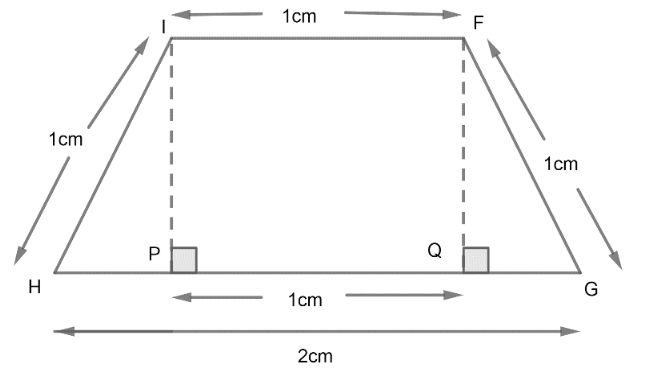
Drawing IP and FQ perpendiculars to side HG. As we know area of trapezium is given by identity;
$\text{Area of trapezium =}\dfrac{1}{2}\left( \text{sum of parallel sides} \right)\times \ \text{Height}$
Or from diagram above, we get
$ar\left( IFGH \right)=\dfrac{1}{2}\left( IF+HG \right)\times IP$
As, we need to find a perpendicular IP or FQ to get an area of given trapezium. Let QG = x, so we get diagram of given trapezium, as;
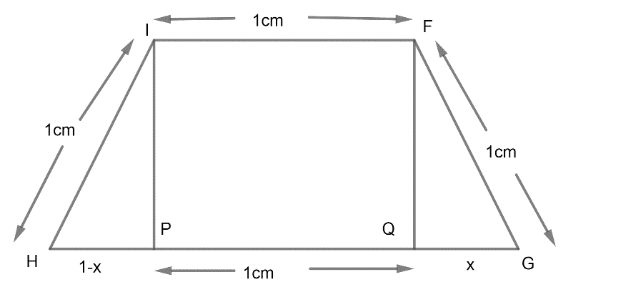
Using Pythagoras Theorem to $\Delta FQG\ and\ IHP$, we get
$\begin{align}
& F{{G}^{2}}=F{{Q}^{2}}+Q{{G}^{2}} \\
& {{1}^{2}}=F{{Q}^{2}}+{{x}^{2}}...........................\left( 5 \right) \\
\end{align}$
And,
$\begin{align}
& I{{H}^{2}}=H{{P}^{2}}+I{{P}^{2}} \\
& {{1}^{2}}={{\left( 1-x \right)}^{2}}+I{{P}^{2}}............\left( 6 \right) \\
\end{align}$
Now, we know that FQ = IP, Hence from equations (5) and (6), we can equate values of ${{\left( FQ \right)}^{2}}\ and\ {{\left( IP \right)}^{2}}$, so we get;
$\begin{align}
& 1-{{x}^{2}}=1-{{\left( 1-x \right)}^{2}} \\
& 1-{{x}^{2}}=1-\left( 1+{{x}^{2}}-2x \right) \\
& -{{x}^{2}}=-1-{{x}^{2}}+2x \\
& or \\
& 2x=1 \\
& x=\dfrac{1}{2} \\
\end{align}$
Hence, $QG=HP=\dfrac{1}{2}$
So, from equation (5), we get
\[\begin{align}
& F{{Q}^{2}}=1-{{x}^{2}} \\
& F{{Q}^{2}}=1-\dfrac{1}{4}=\dfrac{3}{4} \\
& FQ=\dfrac{\sqrt{3}}{2} \\
\end{align}\]
Now, using identity of area of trapezium we get area of shape III be;
$\begin{align}
& Area\left( IFGH \right)=\dfrac{1}{2}\left( 1+2 \right)\times \dfrac{\sqrt{3}}{2} \\
& Area\left( IFGH \right)=\dfrac{3\sqrt{3}}{4}c{{m}^{2}} \\
\end{align}$
Hence, area of shape III$=\dfrac{3\sqrt{3}}{4}c{{m}^{2}}$………… (7)
Now, coming to shape IV, we get;
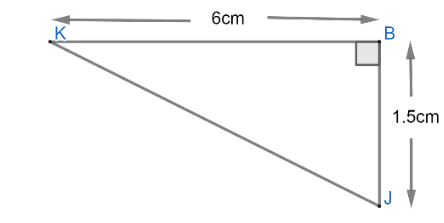
As, by symmetry KB = CD = 6cm and BJ = CE = 1.5cm.
Hence, area of $\Delta KBJ$ can be given as;
\[\begin{align}
& area\text{ }of~\left( \Delta KBJ \right)=\dfrac{1}{2}\times Base\times Height \\
& area\text{ }of~\left( \Delta KBJ \right)=\dfrac{1}{2}\times 1.5\times 6 \\
& area\text{ }of~\left( \Delta KBJ \right)==3\times 1.5 \\
& area\text{ }of~\left( \Delta KBJ \right)=4.5c{{m}^{2}} \\
\end{align}\]
Similarly, Area of $\Delta CDE$ should be equal to area of $\Delta KBJ$ i.e. \[4.5c{{m}^{2}}\].
Hence, area of shape IV \[=4.5c{{m}^{2}}\]………… (8)
And
area of shape V \[=4.5c{{m}^{2}}\]………… (9)
Now, from the equation (1), Area of aeroplane can be given by adding all the areas of shapes calculated from equations (3), (4), (7), (8) and (9), we get;
\[\begin{align}
& Area\text{ }of\text{ }Aeroplane=\dfrac{3}{4}\sqrt{11}+6.5+\dfrac{3\sqrt{3}}{4}+4.5+4.5 \\
& =15.5+\dfrac{3}{4}\sqrt{11}+\dfrac{3\sqrt{3}}{4}c{{m}^{2}} \\
\end{align}\]
As, we know
$\begin{align}
& \sqrt{3}=1.732 \\
& \sqrt{11}=3.316 \\
\end{align}$
Hence, area of plane can be given as;
\[\begin{align}
& Area\ of\ aeroplane=15.5+\dfrac{3}{4}\times 3.316+\dfrac{3\times 1.732}{4} \\
& Area\ of\ aeroplane=15.5+2.487+1.299 \\
& Area\ of\ aeroplane=19.286c{{m}^{2}} \\
\end{align}\]
Note: One can use heron’s formula for calculation of area of $\Delta ABC$.
Heron’s formula is given as;
$\begin{align}
& Area=\sqrt{s\left( s-a \right)\left( s-b \right)\left( s-c \right)} \\
& where\ s=\dfrac{a+b+c}{2} \\
\end{align}$
And a, b, c are sides of a triangle.
Calculation is the important side of this question as well, so take care while calculating the area of all shapes provided.
One can miss any shape while calculating the area of a given aeroplane.
Picture of aeroplane made by Radha is given as;

Here, we have 5 shapes included in the picture of the aeroplane. Hence, we need to find the area of each shape to get the area of aeroplane.
Area of aeroplane = Area of (I + II + III + IV + V)………………… (1)
Area of shape I i.e. $\Delta ABC$ can be calculated as;
As, $\Delta ABC$ is an isosceles triangle i.e. AB = AC and length BC = IF by symmetry of the given aeroplane.

Now, area of $\Delta ABC=\dfrac{1}{2}\times AM\times BC$…………………… (2)
Where AM is drawn as perpendicular to side BC.
Now, $\Delta ABM\text{ and }AMC$are congruent to each other in following way;
$\begin{align}
& AB=AC=5cm \\
& AM=AM\left( Common \right) \\
& \angle AMB=\angle AMC=90{}^\circ \\
\end{align}$
Hence, by RHS property $\Delta ABM\cong AMC$.
So, BM = MC by CPCT.
So, now we have;
$BM=MC=\dfrac{1}{2}$
To find AM, apply Pythagoras Theorem to triangle AMC, we get
$\begin{align}
& A{{C}^{2}}=A{{M}^{2}}+M{{C}^{2}} \\
& {{\left( 5 \right)}^{2}}=A{{M}^{2}}{{\left( \dfrac{1}{2} \right)}^{2}} \\
& 25-\dfrac{1}{4}=A{{M}^{2}} \\
\end{align}$
Or
$\begin{align}
& A{{M}^{2}}=\dfrac{99}{4} \\
& AM=\sqrt{\dfrac{11\times 9}{4}}=\dfrac{3}{2}\sqrt{11} \\
\end{align}$
Hence, area of $\Delta ABC$from equation (2), we get;
$\begin{align}
& ar\left( \Delta ABC \right)=\dfrac{1}{2}\times AM\times BC \\
& =\dfrac{1}{2}\times \dfrac{3}{2}\sqrt{11}\times 1 \\
& ar\left( \Delta ABC \right)=\dfrac{3}{4}\sqrt{11}c{{m}^{2}} \\
\end{align}$
Hence, area of shape I $=\dfrac{3}{4}\sqrt{11}c{{m}^{2}}$…………… (3)
Now, area of shape II can be calculated by area of rectangle i.e. length x breadth as BCFI is a rectangle.
As length of rectangle is BI = CF = 6.5cm and breadth is given as BC = IF = 1cm.
Hence,
\[\begin{align}
& Area\left( BCFI \right)=6.5\times 1 \\
& Area\left( BCFI \right)=6.5c{{m}^{2}} \\
\end{align}\]
So, Area of shape II \[=6.5c{{m}^{2}}\]………………… (4)
As, we can observe that shape III is representing a trapezium i.e. IFGH as;

Drawing IP and FQ perpendiculars to side HG. As we know area of trapezium is given by identity;
$\text{Area of trapezium =}\dfrac{1}{2}\left( \text{sum of parallel sides} \right)\times \ \text{Height}$
Or from diagram above, we get
$ar\left( IFGH \right)=\dfrac{1}{2}\left( IF+HG \right)\times IP$
As, we need to find a perpendicular IP or FQ to get an area of given trapezium. Let QG = x, so we get diagram of given trapezium, as;

Using Pythagoras Theorem to $\Delta FQG\ and\ IHP$, we get
$\begin{align}
& F{{G}^{2}}=F{{Q}^{2}}+Q{{G}^{2}} \\
& {{1}^{2}}=F{{Q}^{2}}+{{x}^{2}}...........................\left( 5 \right) \\
\end{align}$
And,
$\begin{align}
& I{{H}^{2}}=H{{P}^{2}}+I{{P}^{2}} \\
& {{1}^{2}}={{\left( 1-x \right)}^{2}}+I{{P}^{2}}............\left( 6 \right) \\
\end{align}$
Now, we know that FQ = IP, Hence from equations (5) and (6), we can equate values of ${{\left( FQ \right)}^{2}}\ and\ {{\left( IP \right)}^{2}}$, so we get;
$\begin{align}
& 1-{{x}^{2}}=1-{{\left( 1-x \right)}^{2}} \\
& 1-{{x}^{2}}=1-\left( 1+{{x}^{2}}-2x \right) \\
& -{{x}^{2}}=-1-{{x}^{2}}+2x \\
& or \\
& 2x=1 \\
& x=\dfrac{1}{2} \\
\end{align}$
Hence, $QG=HP=\dfrac{1}{2}$
So, from equation (5), we get
\[\begin{align}
& F{{Q}^{2}}=1-{{x}^{2}} \\
& F{{Q}^{2}}=1-\dfrac{1}{4}=\dfrac{3}{4} \\
& FQ=\dfrac{\sqrt{3}}{2} \\
\end{align}\]
Now, using identity of area of trapezium we get area of shape III be;
$\begin{align}
& Area\left( IFGH \right)=\dfrac{1}{2}\left( 1+2 \right)\times \dfrac{\sqrt{3}}{2} \\
& Area\left( IFGH \right)=\dfrac{3\sqrt{3}}{4}c{{m}^{2}} \\
\end{align}$
Hence, area of shape III$=\dfrac{3\sqrt{3}}{4}c{{m}^{2}}$………… (7)
Now, coming to shape IV, we get;

As, by symmetry KB = CD = 6cm and BJ = CE = 1.5cm.
Hence, area of $\Delta KBJ$ can be given as;
\[\begin{align}
& area\text{ }of~\left( \Delta KBJ \right)=\dfrac{1}{2}\times Base\times Height \\
& area\text{ }of~\left( \Delta KBJ \right)=\dfrac{1}{2}\times 1.5\times 6 \\
& area\text{ }of~\left( \Delta KBJ \right)==3\times 1.5 \\
& area\text{ }of~\left( \Delta KBJ \right)=4.5c{{m}^{2}} \\
\end{align}\]
Similarly, Area of $\Delta CDE$ should be equal to area of $\Delta KBJ$ i.e. \[4.5c{{m}^{2}}\].
Hence, area of shape IV \[=4.5c{{m}^{2}}\]………… (8)
And
area of shape V \[=4.5c{{m}^{2}}\]………… (9)
Now, from the equation (1), Area of aeroplane can be given by adding all the areas of shapes calculated from equations (3), (4), (7), (8) and (9), we get;
\[\begin{align}
& Area\text{ }of\text{ }Aeroplane=\dfrac{3}{4}\sqrt{11}+6.5+\dfrac{3\sqrt{3}}{4}+4.5+4.5 \\
& =15.5+\dfrac{3}{4}\sqrt{11}+\dfrac{3\sqrt{3}}{4}c{{m}^{2}} \\
\end{align}\]
As, we know
$\begin{align}
& \sqrt{3}=1.732 \\
& \sqrt{11}=3.316 \\
\end{align}$
Hence, area of plane can be given as;
\[\begin{align}
& Area\ of\ aeroplane=15.5+\dfrac{3}{4}\times 3.316+\dfrac{3\times 1.732}{4} \\
& Area\ of\ aeroplane=15.5+2.487+1.299 \\
& Area\ of\ aeroplane=19.286c{{m}^{2}} \\
\end{align}\]
Note: One can use heron’s formula for calculation of area of $\Delta ABC$.
Heron’s formula is given as;
$\begin{align}
& Area=\sqrt{s\left( s-a \right)\left( s-b \right)\left( s-c \right)} \\
& where\ s=\dfrac{a+b+c}{2} \\
\end{align}$
And a, b, c are sides of a triangle.
Calculation is the important side of this question as well, so take care while calculating the area of all shapes provided.
One can miss any shape while calculating the area of a given aeroplane.
Recently Updated Pages
Fill in the blanks with suitable prepositions Break class 10 english CBSE

Fill in the blanks with suitable articles Tribune is class 10 english CBSE

Rearrange the following words and phrases to form a class 10 english CBSE

Select the opposite of the given word Permit aGive class 10 english CBSE

Fill in the blank with the most appropriate option class 10 english CBSE

Some places have oneline notices Which option is a class 10 english CBSE

Trending doubts
Fill the blanks with the suitable prepositions 1 The class 9 english CBSE

How do you graph the function fx 4x class 9 maths CBSE

When was Karauli Praja Mandal established 11934 21936 class 10 social science CBSE

Which are the Top 10 Largest Countries of the World?

What is the definite integral of zero a constant b class 12 maths CBSE

Why is steel more elastic than rubber class 11 physics CBSE

Distinguish between the following Ferrous and nonferrous class 9 social science CBSE

The Equation xxx + 2 is Satisfied when x is Equal to Class 10 Maths

Differentiate between homogeneous and heterogeneous class 12 chemistry CBSE

